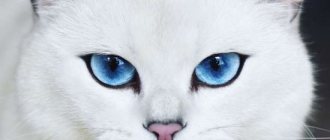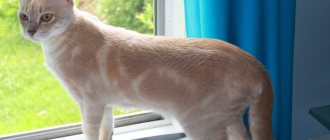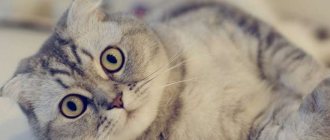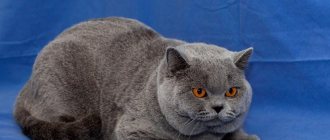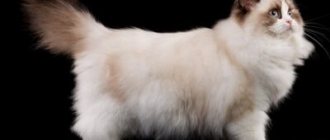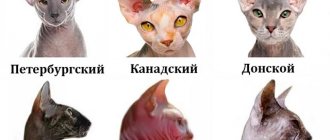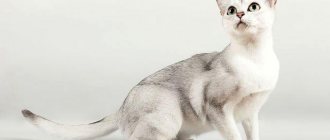Active breeding of this cat breed began in the 60s of the 20th century, and in 1998, according to CFA data, this breed was one of the ten most popular cat breeds. The artificial crossing of the Burmese and Siamese cats was preceded by the natural crossing of these two cat breeds living in the vicinity of Thailand during the reign of the Ayudhaya dynasty, between 1350 and 1767. The first chocolate Siamese cats appeared in England in the 19th century, along with the more popular blue-eyed color-point Siamese cats. At the beginning of the 20th century, experts identified blue-eyed cats among Siamese cats, and the remaining varieties of Siamese were prohibited from participating in exhibitions, so many species gradually lost their popularity and disappeared. But the Tonkinese cat was able to regain interest thanks to the Canadian breeder Margaret Conroy, who crossed a sable-colored Burmese with a seal-point Siamese cat. Thanks to this experiment, light brown kittens with unusual aquamarine eyes were born. Initially, the breed was called the Golden Siamese, and already in 1971 the modern name Tonkinese cat appeared, as experts suggest, the cat received this name from the name of the Tonkin lowland, located in Vietnam, although representatives of this breed have never been in this area. This name was intended to emphasize the refined exotic beauty of these cats. DescriptionCharacterCareCost
Description of the breed
The Tonkinese cat is the result of crossing Burmese and Siamese cats. The Tonkinese cat is most popular among people who like the Siamese cat but would like a cat with a more moderate head and body shape. The Tonkinese is slimmer than the Burmese, but has a denser build than the Siamese cat. Tonkinese are unusually heavy compared to their size. These are strong, hardy animals with developed muscles. Body weight ranges from 3 to 5 kg, males are larger than females. The wedge-shaped head of the Tonkinese is elongated, the ears are medium-sized, set high, and the almond-shaped eyes are located slightly obliquely. The color can be of three different types: solid, color point and mink. For participation in shows, most associations welcome the mink color; only some associations accept color-point and solid colors for participation in shows. A characteristic feature of the mink color is its blue eyes. Blue eyes are also found in color-point cats, and in solid-colored cats they range from greenish to golden. Currently, the natural color standard is characterized by a warm brown coat with dark chocolate markings, and a pale gray coat with dark gray markings, which is called platinum. The color called champagne is also welcome - it is a light beige color with faint, barely noticeable brown markings; There is also a blue mink color, blue with gray-blue markings. Less common colors are fawn, cream, red, and cinnamon. They are not accepted by most associations.
Genetics and health
Since the breed was originally bred artificially, it acquired a predisposition to a number of diseases at the genetic level. Please note that with proper care they can be avoided. Tonkinese are prone to just a few ailments: asthma and diseases of the cardiovascular system. Also, 5%-7% of kittens have strabismus of varying degrees.
Photos of Tonkinese cats:
Tonkinese cats are in good health. With them, you don't have to visit the veterinarian too often and organize complex feeding plans. At home, such pets can safely live 15-18 years.
There are many cases where the Tonkinese lived up to 22 years.
Such an impressive age is the result of good genes, because cats are a mixture of only two species, and not long-term crossbreeding.
Character
By its nature, Tonkinese is very pleasant to communicate with. This is a kind, active, smart cat. The Tonkinese will not irritate you with increased talkativeness like a Siamese cat, and his voice is quieter and more pleasant. The Tonkinese loves to accompany its owner everywhere, he will sit next to you, follow you on your heels, flirt and attract your attention in various ways. This cat breed is not suitable for those who are often away from home. To save your pet from loneliness when you are away, get another cat so that they can play together and spend time without you.
Story
Breeders from two countries – Canada and the USA – simultaneously began breeding the Tonkinese cat breed.
Canadian breeders managed to do this a little earlier than their American colleagues - around the 60s. XX century Of course, when the breeders began to develop a new breed, it was not even called Tonkinese in the minds of the breeders. Both American and Canadian experts have set themselves the task of breeding a Burmese-type cat. Representatives of the new breed had to have the color of a Siamese cat, but at the same time be of strong build. And the breeders of the two countries, without agreeing, followed the same path in attempts to create a new breed - they began to cross Siamese and Burmese cats. When the result was achieved, both in America and Canada these cats were called golden Siamese. And later it was renamed the Tonkinese cat (Tonkinese).
In the USA, this is now one of the most beloved and popular cats, but in Russia this breed is not particularly common.
Breeding Tonkinese cats is associated with certain difficulties - usually only half of the kittens in a litter have the required mink color. This means that only they can participate in further breeding of the breed.
Care
Tonkinese are unpretentious in care. Their health is good. Since the Tonkinese coat is short and lies close to the body, it does not require much attention when grooming. It is enough to brush your cat once a week, and it will look great. For grooming, it is better to use a rubber brush with a concave surface to more effectively remove dead hair. As for the rest, you should do everything the same as when caring for a regular cat, periodically bring the cat for examination by a veterinarian, vaccinate and carry out grooming procedures.
Maintenance and care
Representatives of the Tonkinese cat breed do not require special personal care, just do the following:
- Buy a tray that is suitable for your cat in size and weight. For example, kittens need a toilet with low sides, and as a mesh for litter for an adult Tonkinese, you need to choose the option with the largest number of supports.
- Place a scratching post in your home and, if necessary, shorten your pet’s claws with special tweezers.
- A bed can be purchased according to the animal's preferences. sexpromo It should be placed in a warm place without drafts.
- Considering the playful nature of Tonkinese cats, you need to place a sufficient number of toys in the house, and a multi-level bed will definitely appeal to your pet.
A multi-level play complex, which includes beds and scratching posts, will arouse the interest of an active cat.
- Every few days, examine your pet's eyes and ears for dark deposits.
- Brush once a week, preferably with a brush glove.
- Bathe only when the coat is really dirty.
Considering the investigative nature of the Tonkinese, when keeping an animal at home, you should put a net over the windows that open, and put a harness on your pet during walks.
Video: caring for a Tonkinese cat
Tonkinesis nutrition
There are no special features in the diet of Tonkinese cats. It is enough to follow the following recommendations:
- use food from large manufacturers designed specifically for the Tonkinese breed;
- exclude from the diet: yeast;
- corn or maize;
- corn gluten;
- corn oil;
- animal mixture;
- ground liver (unless it says whose liver it is);
- bread crumbs;
- soybean oil;
- wheat (allergen);
- tomato mixture (tomatoes are allowed);
- potato food;
- cellulose;
- soy protein concentrate.
According to reviews from owners, despite its large weight (about 5 kg), the Tonkinese cat does not have a big appetite, so you can calmly pour dry food into a bowl and not worry that the animal will immediately eat the daily portion and ask for more, despite obvious signs of overeating .
If you do not accept this option and want to treat your cat with fresh food every time, then keep in mind that you need to feed an adult pet no more than 1-2 times a day, and kittens up to 6 months - 3 times. However, in this case, you need to observe feeding hours so that the pet feels hungry at the usual time for eating.
The owner’s main task is to choose a balanced diet for the cat, taking into account the age, health and state of pregnancy or feeding kittens.
Health of Tonkinese cats
Tonkinese can carry the following diseases:
- Liver amyloidosis is a disease in which amyloid (fibers of a waxy substance of a protein nature) is deposited in the liver, causing degeneration of liver cells, disruption of its structure and nutrition, which leads to increased levels of liver enzymes, coagulopathy, liver failure, intoxication with damage to other organs;
- upper respiratory tract diseases;
- cardiomyopathy - enlargement of the heart muscle in cats;
- formation of tartar;
- gingivitis - inflammation of the gums.
It is worth keeping in mind that the diseases of these cats of the breed are hereditary. They also showed increased sensitivity to some vaccines and anesthetics.
Meanwhile, Tonkinese cats have high immunity, so with good heredity, proper nutrition and care, they will not get sick. There are cases when Tonkinese calmly endured long sea voyages without the ailments characteristic of this type of recreation.
Video: characteristics of the Tonkinese cat
Cat breeds
Did you think you knew everything about cat breeds? Test your knowledge on the official website of German natural pet food Bosch. We present an extensive catalog of various cat breeds. The section contains more than 70 reference articles. The names of cat breeds with detailed descriptions and high-quality photos will be of interest to both experienced cat lovers and those who are just thinking about buying an animal.
If you do not want to search alphabetically, write the desired cat breed and use the search bar. Each description of cats with photographs is divided into several parts: a brief information about the breeding of the breed, then a detailed description of the physiological characteristics - for example, the shape of the head, ears and eyes, the size of the body, the nature of the color, the length of the coat, etc.
Features of the Tonkinese cat breed
For those who are accustomed to seeing an independent cat in their pet, which “you can’t find in the daylight,” this breed is not suitable. On the contrary, buy a Tonkinese cat .
Who has other animals, and often has guests in the house. Tonkinese easily finds a common language with everyone. He will accompany you to work, try to fall asleep on your sofa, babysit your children, and even learn to fetch toys and small things in his teeth.
The photo shows the colors of the Tonkinese cat
Surprisingly, American researchers are confident that Tonkinese are real psychics. And at the same time they have telepathy. Observing the animals, experts noted that cats can predict the actions of their owners several steps ahead.
At the same time, they try to protect their beloved household members from negative energy. And even make peace if someone in the family is quarreling. Tonkinese doctors in the USA treat children suffering from autism and paralysis. It is believed that cats help children adapt to our harsh world.
The Tonkinese cat has an amazing character. She is smart, playful and has a sweet cat-like voice. They also do not harm the owners. If a cat is scolded for an offense, he will never repeat his mistake again.
At the same time, representatives of this breed are distinguished by excellent memory and adapt to the rhythm of life of their household. Truly kind cats should be protected from the outside world themselves. They can easily become prey on the street, so "free range" for Tonkinese is exceptional.
Descriptions, photographs and character
For future owners of graceful creatures, the section on the character of various breeds of cats and kittens will be extremely useful. Here you can find out how your pet tends to communicate with people - affectionate and trusting or emphatically independent and even sometimes aggressive? Or perhaps kittens are future excellent hunters, playful and curious, which means it will be impossible to lock the warlike tailed one within four walls. A detailed description of the breed will help you make the right choice. We especially note that the catalog contains expensive and rare cat breeds.
Often the determining factor when choosing a pet is its appearance. Especially if you entrust the choice of a pet to children. But when looking at photos of cat breeds, do not forget that only a careful acquaintance with the description of the character can serve as a guarantee that in the future there will be no disagreements between you and a tailed family member.
Tonkinese cat price
The price of a Tonkinese cat starts from 20 thousand rubles (8,000 hryvnia). Moreover, for this price you can buy a kitten that meets the breed standards, but has some disadvantages (for example, not mink color).
The photo shows a Tonkinese cat kitten
The cost of a breed and show kitten below 35 thousand rubles is quite difficult to find. The price is also influenced by the pedigree, external characteristics of the cat and its gender. Not only the cost is affected by the colors of Tonkinese cats . For inappropriate color, beauties are disqualified from exhibitions and are not allowed to breed.
Points are also deducted for yellow eyes, kinked tail and white markings. As noted above, it is not only external characteristics that make the Tonkizen a special breed. A pet with any eye color will become a wonderful gentle friend and devoted family member.
History of origin
The fur was brown, but the eyes were bluish-green or yellow. During the breeding program, breeders fixed and exaggerated the “WongMau” type animal, which became the progenitor of the Burmese cat. Siamese cats were also used in this program. The result of breeding was kittens of a darker color than those of “WongMau” and other unusual babies.
Tonkinese were an intermediate link between Siamese and Burmese cats.
These babies were point color (uniform light color). The light blue eyes had a greenish tint. They became the first Tonkinese kittens.
But for a long time they were considered only hybrids, and it was not possible to register them. No one has ever hidden the fact that the Tonkinese cat was obtained through hybridization, but now it already has its own standard and quite official status.
True, she achieved recognition only among American breeders. Experts from European countries have still not been able to solve the problem associated with the status of this breed. In general, the description of the Tonkinese cat consists of a complex of traits passed on to it from the Burmese and Siamese.
Color
The mink color and aquamarine-colored eyes are the main features that distinguish the Tonkinese from other cats. The breed standards of different felinological organizations include a large number of different color options: seal, chocolate, cinnamon, red, blue, lilac, fawn, cream, tortie.
The pattern is something between Siamese colorpoint and Burmese solid sepia. This means that the Tokinese cat can be:
- Point color – have a clear contrast and be as close in color as possible to the Siamese breed;
- Mink – with a slightly blurred contrast – is the most common color option for Tonkinese cats;
- Solid – have weak contrast and colors close to Burmese sepia.
It should be noted that the Tonkinese breed will acquire its final color only by 18 months of age. And it has been noticed that the older a cat gets, the more likely it is that its fur will darken a little.
The famous eye color of the Tonkinese is aquamarine. But there are other variations. For example, point cats, and especially Siamese cats, may have blue eyes, with a possible purple tint. Pets with a solid color will have yellow-green eyes, similar to the Burmese. This same variation of aquamarine eyes is the hallmark of cats that are exclusively mink in color.

